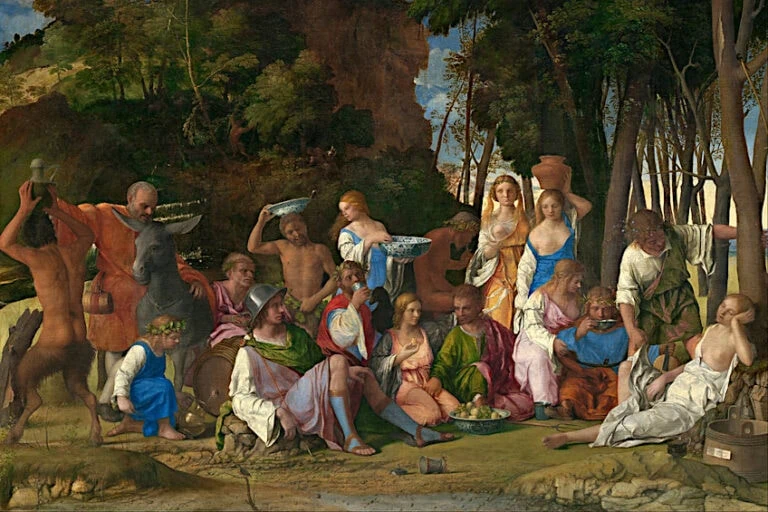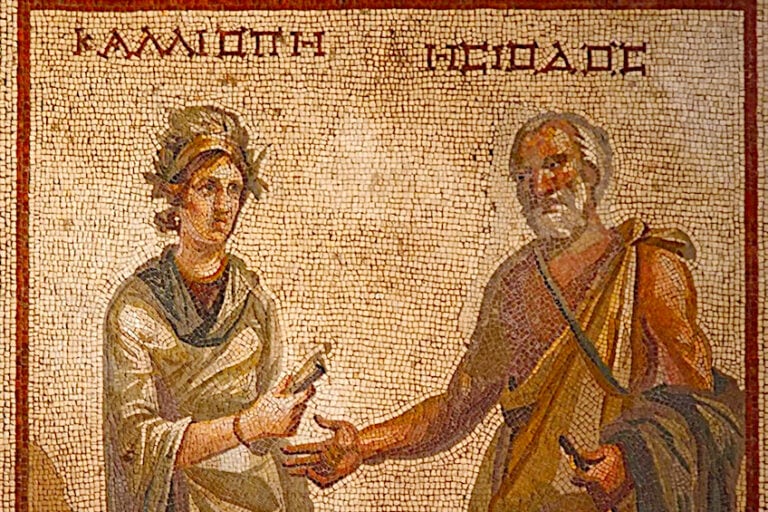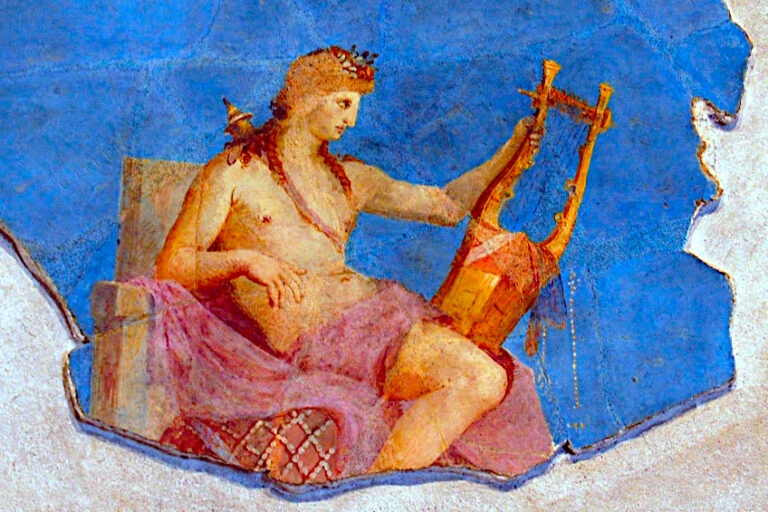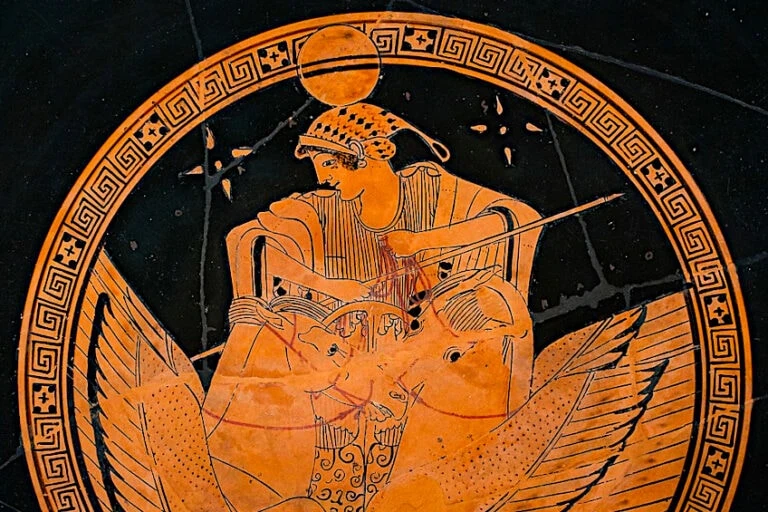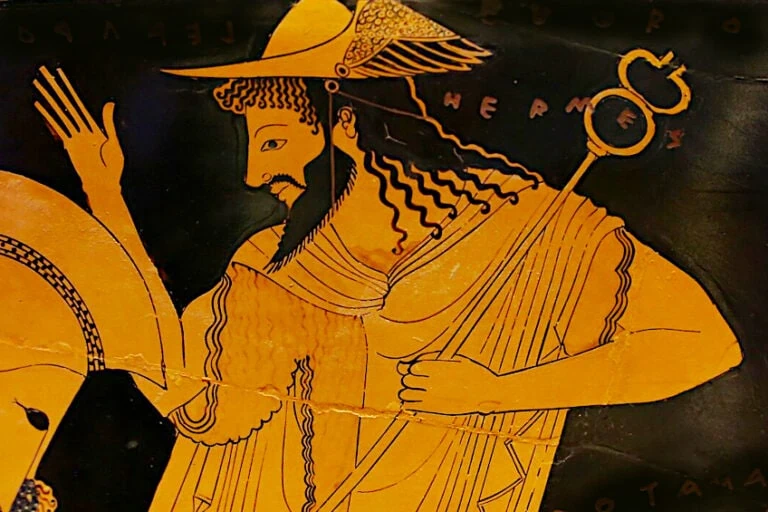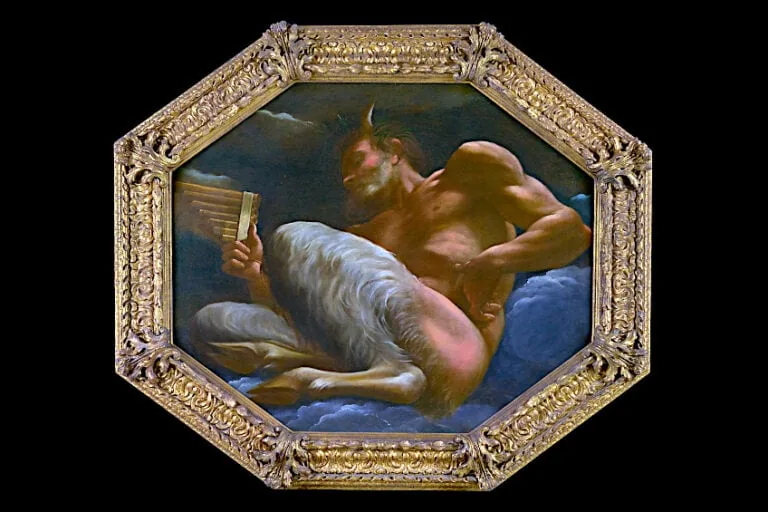Greek Goddess Nike – The Personification of Victory
Who is the goddess of victory in Greek mythology? The Greek goddess Nike was regarded as the goddess of victory by the ancient Greeks. In fact, the Nike meaning in Greek stems from the ancient Greek word for victory. Today, let us dive into the world of the Greek goddess Nike by finding out all there is to know about the Nike goddess symbols and mythology, and help answer your related questions, such as “what is the sporting brand Nike named after?”.
Contents
Exploring the Mythology of the Greek Goddess Nike
| Name | Nike |
| Gender | Female |
| Symbols | Wings, golden sandals, and wreaths |
| Personality | Competitive and determined |
| Domains | Wars and competitions |
| Parents | Pallas and Styx |
| Spouse | None |
The Greek goddess Nike is the revered deity of victory, both in battle and in peaceful competition, which includes music, art, and sports. Her close connection with Zeus and Athena led to her becoming their celestial charioteer, and she is regularly represented as such.
Nike also typically appears as a figure standing in the palm of the hands of these two gods.
Nike is recognized for many great attributes that make her an important figure in mythology, but her speed and power are particularly notable.
 Nike in the hand of Pallas Athena from a modern reinterpretation of the chryselephantine statue of Athena from the Parthenon by Joseph Tautenhayn, Carl Kundmann, and Hugo Haerdtl (between 1893 and 1902); CC BY-SA 3.0 AT, via Wikimedia Commons
Nike in the hand of Pallas Athena from a modern reinterpretation of the chryselephantine statue of Athena from the Parthenon by Joseph Tautenhayn, Carl Kundmann, and Hugo Haerdtl (between 1893 and 1902); CC BY-SA 3.0 AT, via Wikimedia Commons
Background and Family
In most traditions, the Greek goddess Nike is the child of Styx, the River that flows through the underworld who guarantees the oaths of the gods, and the Titan Pallas. In the Homeric Hymn to Ares, Nike is also the daughter of this god of violent warfare. She had three siblings, Zelus (zeal), Cratus (power), and Bia (force). In later traditions, Nike was a companion of Pallas Athena, as Pallas was one of this goddess’ most frequently used epithets.
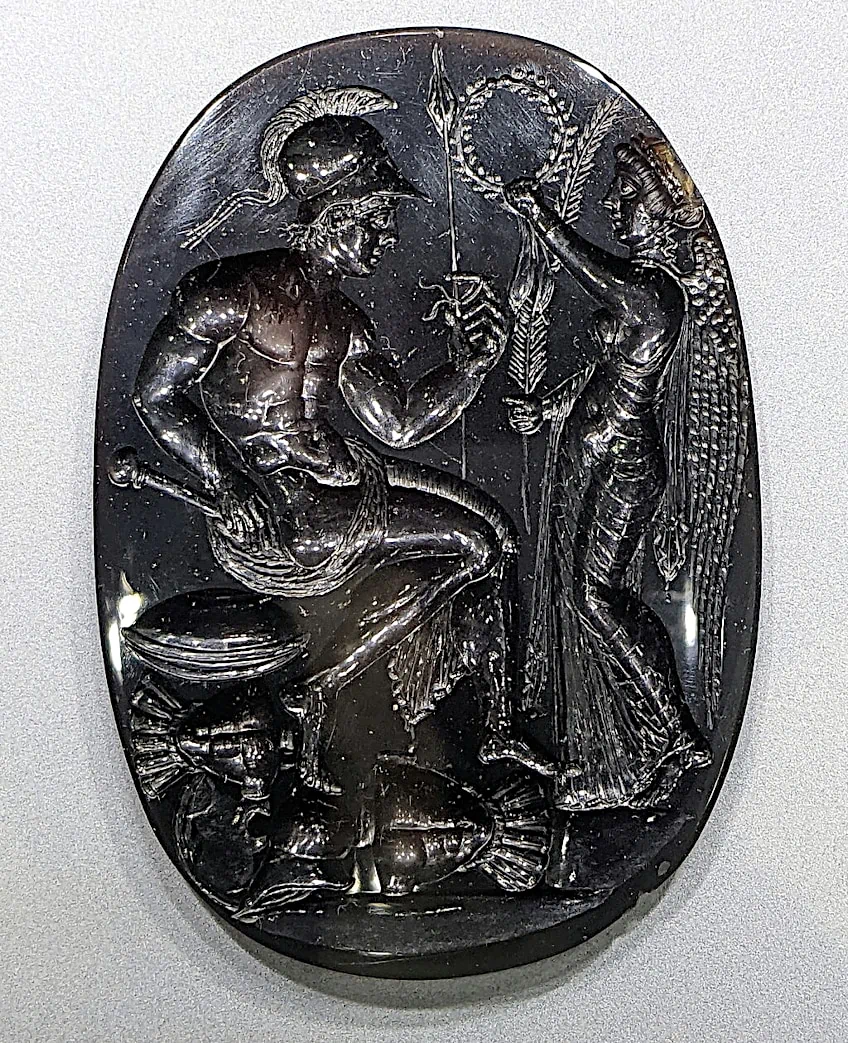 Intaglio with a depiction of Nike celebrating Ares; Naples National Archaeological Museum, CC0, via Wikimedia Commons
Intaglio with a depiction of Nike celebrating Ares; Naples National Archaeological Museum, CC0, via Wikimedia Commons
Nike’s Family and Their Connection to Zeus
Nike’s family’s association with Zeus started with the onset of the Titan War. This epic war began when Zeus chose to rebel against his Cronus. His father, Cronus was aware of a prediction from his Uranus, that one of his sons would someday overthrow him, therefore he ate his offspring in order to prevent this from taking place. Zeus was concealed as a baby, and when he was older, he gave his father a wine-mustard combination that caused him to vomit, freeing all of Zeus’ siblings.
Zeus enlisted the assistance of numerous gods and goddesses to bring down his father, and Styx volunteered her four children to assist him.
The conflict was finally won by Zeus and the Olympians. Even after the fight, Nike maintained a strong connection with Zeus, and Zeus allowed Nike and her siblings to dwell in Olympus with him. They spent their days on Mount Olympus with Zeus, and Nike became the celestial charioteer for both Zeus and the goddess Athena. She was often present in tournaments, flying about and congratulating the winner.
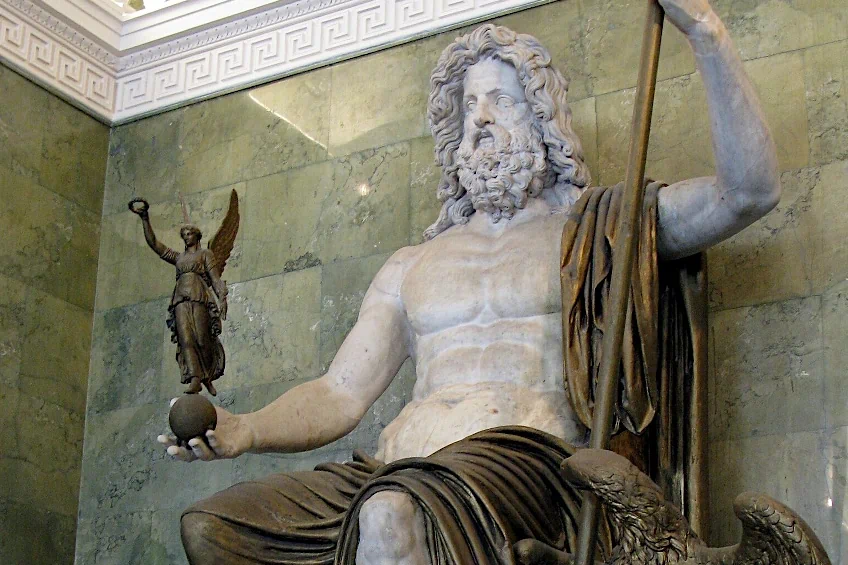 1st Century CE statue of Zeus/Jupiter holding Nike and a scepter with 19th Century restoration; Andrew Bossi, CC BY-SA 2.0, via Wikimedia Commons
1st Century CE statue of Zeus/Jupiter holding Nike and a scepter with 19th Century restoration; Andrew Bossi, CC BY-SA 2.0, via Wikimedia Commons
Origins
Athena and Nike are both connected with victory, which has led to considerable debate about Nike’s origins. Some academics believe Nike was formerly an aspect of Athena, which was made up of Boulaia, Ergane, and Nike. The hypothesis holds that Nike finally separated from Athena to establish her own individual personality. In another study, Baudrillart expresses a similar belief that Nike was originally a part of the Greek goddess Athena and split from her sometime in the 5th century.
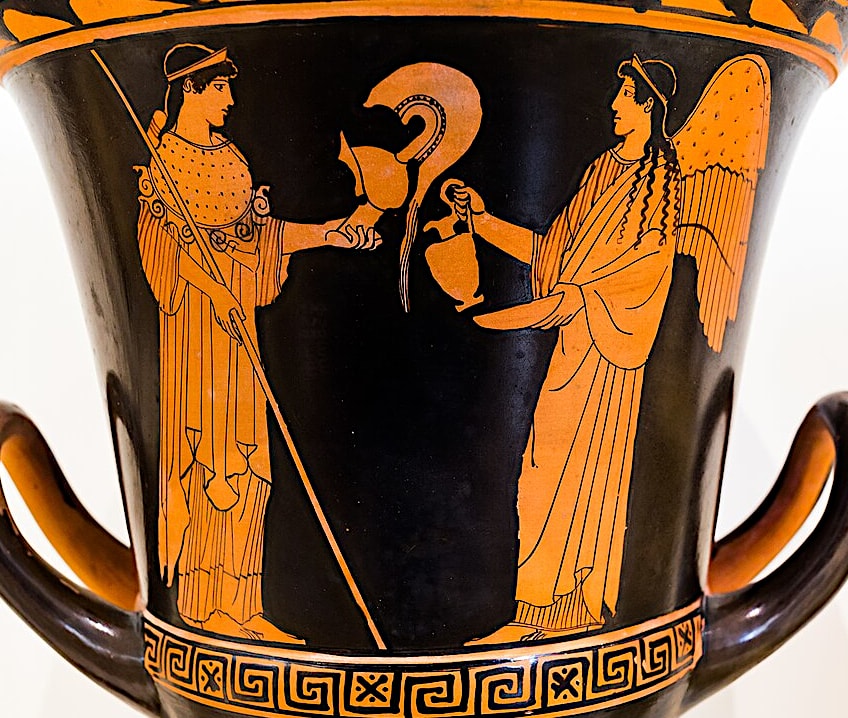 Attic red-figure calyx-crater with a depiction of Nike and Athena by the Achilles Painter (c. 455-450 BCE); ArchaiOptix, CC BY-SA 4.0, via Wikimedia Commons
Attic red-figure calyx-crater with a depiction of Nike and Athena by the Achilles Painter (c. 455-450 BCE); ArchaiOptix, CC BY-SA 4.0, via Wikimedia Commons
However, he believes that the Athena Nike identity coexisted with the separate Nike personality. Unlike these scholars, E.E. Sikes thought that Nike had a very different personality from Athena. Nike, according to Sikes, emerged as a separate divinity from Athena because Nike signified triumph in athletic, musical, and military competitions, but Athena’s authority was primarily restricted to military victories.
According to Sikes, the belief that Nike evolved from Athena emerged from the conflation of the two deities in Athens, where Athena Nike, and Nike coexisted.
Role
Nike was admired and recognized for her role in bringing success and victory in combat as well as other contests, including athletic tournaments. She’d swoop down to the sports stadium or battlefield to bestow her support on the appropriate party. The Greek goddess Nike was regarded as a benign divinity who encouraged and praised individuals who exemplified excellence, talent, and heroism. As mentioned before, Nike was very close to Zeus, and acted as his charioteer, a role she is also depicted performing for his son Herakles in ancient art.
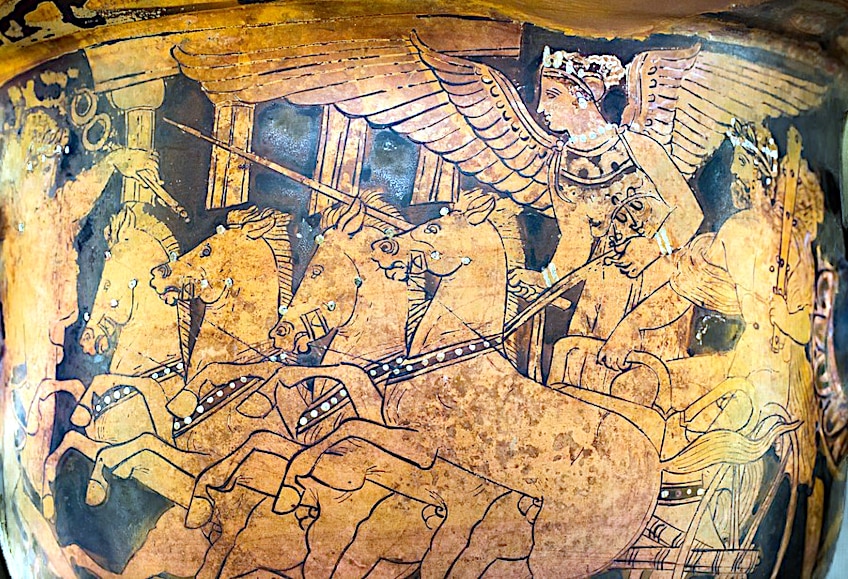 Attic red-figure bell-krater with a depiction of Nike driving a chariot with Herakles as passenger by the Painter of London (c. 390-370 BCE); ArchaiOptix, CC BY-SA 4.0, via Wikimedia Commons
Attic red-figure bell-krater with a depiction of Nike driving a chariot with Herakles as passenger by the Painter of London (c. 390-370 BCE); ArchaiOptix, CC BY-SA 4.0, via Wikimedia Commons
She was also regarded as Athena’s attendant and symbolized the triumphant element of war and the glory that came with victory on the battlefield in this capacity. Nike was adored not just during times of war and struggle, but also during times of peace.
She presided over religious festivals connected to military victory and athletic tournaments, including the ancient Olympic Games. Her presence represented victory and celebration of the Greek people’s accomplishments.
Nike’s Personality and Attributes
Nike, unlike some of the other main Olympian deities, is usually represented as a personification of victory. Her personal attributes are most often reflected in the concepts that she embodies as a divine expression of accomplishment.
The Greek goddess Nike is intimately connected with rivalry and competitiveness.
She represents the drive to prevail and excel in different pursuits, such as fighting and sports competitions. Nike’s presence represents a desire for perfection and the pursuit of success, which makes her naturally competitive.
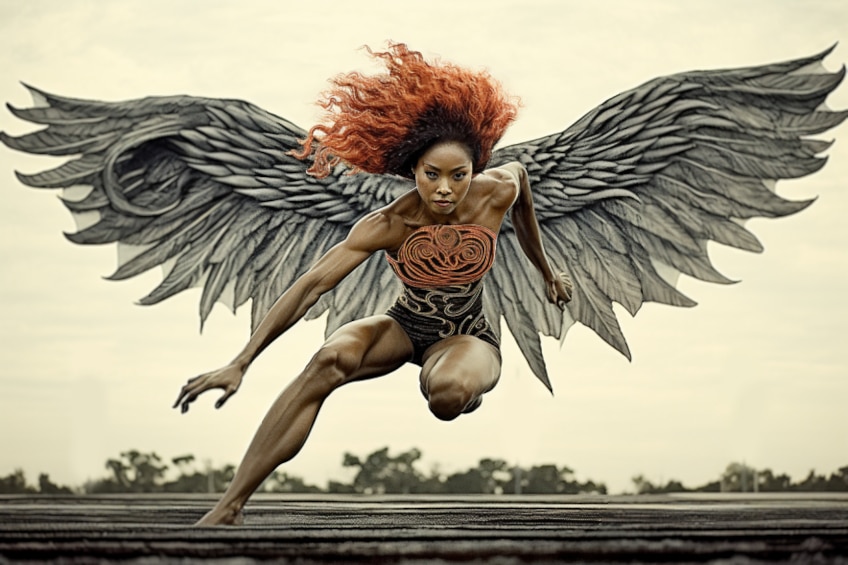 Nike as symbolic of the competitive spirit and an overriding drive to win; artist’s impression
Nike as symbolic of the competitive spirit and an overriding drive to win; artist’s impression
Her connections to victory and achievement inspire people to push themselves to greatness and realize their ambitions. Nike’s presence is thought to inspire and motivate individuals seeking greatness, encouraging them to push their limitations and achieve in their undertakings. Nike signifies the perseverance and dedication necessary to win. She personifies the unrelenting attitude and will that are required to overcome difficulties and succeed.
Nike’s depiction as a winged goddess represents her quick and determined attitude, highlighting her drive to deliver prosperity to those she supports.
Nike Goddess Symbols
Nike is frequently represented with a variety of symbols and traits. She often appears winged to represent her power and agility. Her enormous wings are by far her most notable feature. In fact, unlike earlier portrayals of winged gods who might adopt the shape of birds in myths, Nike is exceptional in having preserved hers by the classical era.
 Attic white-ground lekythos with a depiction of Nike holding a burning torch (c. 480 BCE); Louvre Museum, Public domain, via Wikimedia Commons
Attic white-ground lekythos with a depiction of Nike holding a burning torch (c. 480 BCE); Louvre Museum, Public domain, via Wikimedia Commons
She is sometimes depicted with gold attire and other jewelry, like the Staff of Hermes, which is thought to provide incredible agility and swiftness. Nike often appears carrying a palm branch, which was typically used to represent the time of calm that followed victory. Above all, Nike is connected with the laurel wreath. In ancient times, those who won wars were typically presented with a wreath of laurel leaves. This was intended to represent the grandeur and fame that came with victory in combat.
As the Goddess of Victory, she was often depicted in Ancient Greek art flying about the battlefield and distributing the laurel wreath to successful combatants.
Portrayal in Art
Nike regularly appears in the Archaic era of ancient Greek art in a “kneeling run” stance, her head bent to the side and gazing at the observer while her body races ahead. The statue of Nike made from marble, discovered in Delos circa 550 BCE and presumably created by Arkhermos of Chios, exhibits this style of posture. Her right arm is bent and extending at an angle, while her left arm is bowed and resting on her upper thigh. Her wings are linked to her upper back, and her body sprints to the side, her head tilted to towards the viewer rather than the destination. According to Richard Neer, this position, with its wings, running stance, and flowing clothes, was intended to represent the goddess’s quick speed.
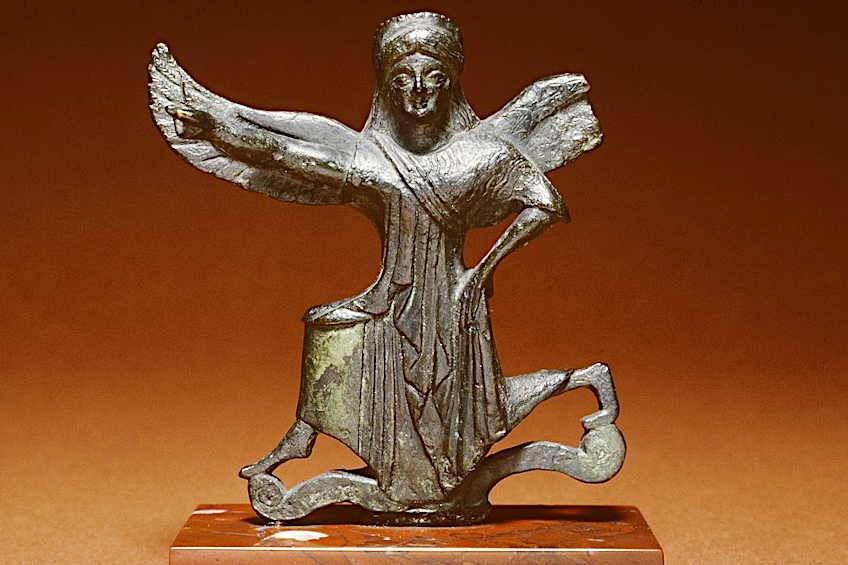 Fragment of bronze votive object depicting Nike in flight (c. 500 BCE); Walters Art Museum, Public domain, via Wikimedia Commons
Fragment of bronze votive object depicting Nike in flight (c. 500 BCE); Walters Art Museum, Public domain, via Wikimedia Commons
Her legs straighten as time passes, and her motion becomes a more slight alighting action with a minor forward component. Paionios’ statue of Nike unearthed in the Temple of Zeus at Olympia is a representation of a phase of transition in motion from the “kneeling run” to the alighting and stride positions.
By the mid-Classical era and the beginning of the Hellenistic period, sculptures of Nike began to depict her with nearly totally straight legs in an alighting stance designed to convey an appearance out of nowhere as opposed to rushing into view.
This little downward and forward motion is seen in Magna Grecia’s Capitoline Nike (460 BCE). Nike statuettes were frequently placed in the hands of bigger deities throughout the Classical era. Pheidias’ statue of Zeus at Olympia is one such instance. In addition to a smaller Nike figurine in one hand and a spear in the other, Pheidias’ cult figure of Athena had a spear in one hand and a smaller Nike statuette in the other. Both Athena’s and Zeus’ Nike sculptures were winged. Nike is only shown without wings in Greek sculptures when depicted as an attribute of another divinity, such as Athena.
The Greek Mythology of Nike
Earlier, we touched on Nike’s role in the battle involving Zeus. However, this is far from the only time that she was involved in Greek mythology. The Greek goddess Nike plays an important part in supporting the gods in their war against the Giants in the Gigantomachy, a mythological struggle between the gods and the Giants who originated from Uranus’ castrated blood. Nike’s presence in the Gigantomachy symbolizes the god’s victory over the Giants, as well as the conquest of order over chaos.
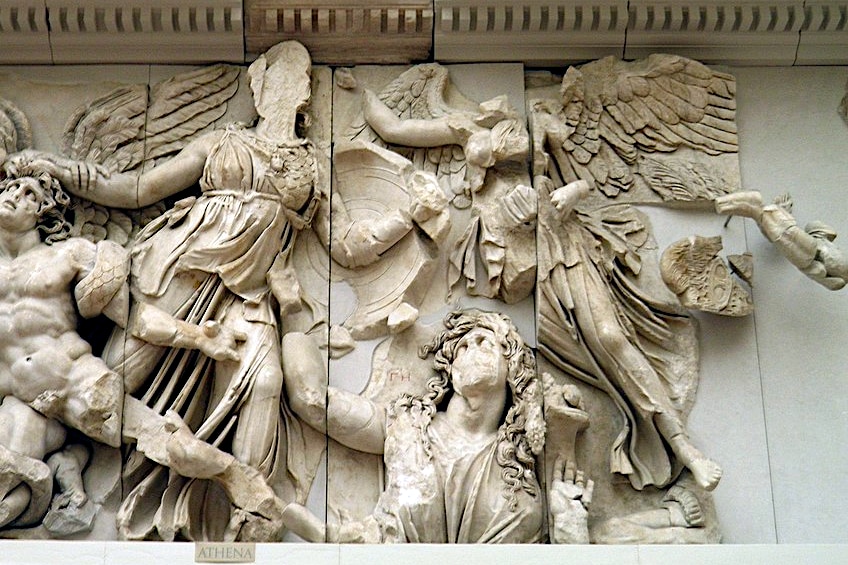 Detail of the frieze of the Great Altar at Pergamon showing Nike conferring victory on Athena during the Gigantomachy (2nd Century BCE); Carole Raddato from FRANKFURT, Germany, CC BY-SA 2.0, via Wikimedia Commons
Detail of the frieze of the Great Altar at Pergamon showing Nike conferring victory on Athena during the Gigantomachy (2nd Century BCE); Carole Raddato from FRANKFURT, Germany, CC BY-SA 2.0, via Wikimedia Commons
Nike and Typhon
Nike is referred to as a representative of Athena dispatched to help Zeus in his war against Typhon in Nonnos’ Dionysiaca, an epic poem that describes Dionysus’ travels. Typhon, according to Nonnos, was a ferocious and enormous monster that fought Zeus for dominion. Typhon was a powerful adversary, and Zeus found himself in desperate need of assistance to defeat him. As a result, Athena sent Nike as her agent and messenger to aid Zeus in this epic battle.
In the last days of the Titanomachy, when Typhon lay siege to Olympus, Nike, in the shape of Leto, chastised Zeus for his hesitation in facing Typhon and pushed him to collect his thunderbolts to get ready to defend Olympus.
She listed all the gods who had given up and left the war in her speech, including Hermes, Ares, Apollo, Hephaistos, and Aphrodite. She also described the consequences of letting Typhon triumph, which included the downfall of Olympus and the assault and captivity of Zeus’ daughters Artemis and Athena.
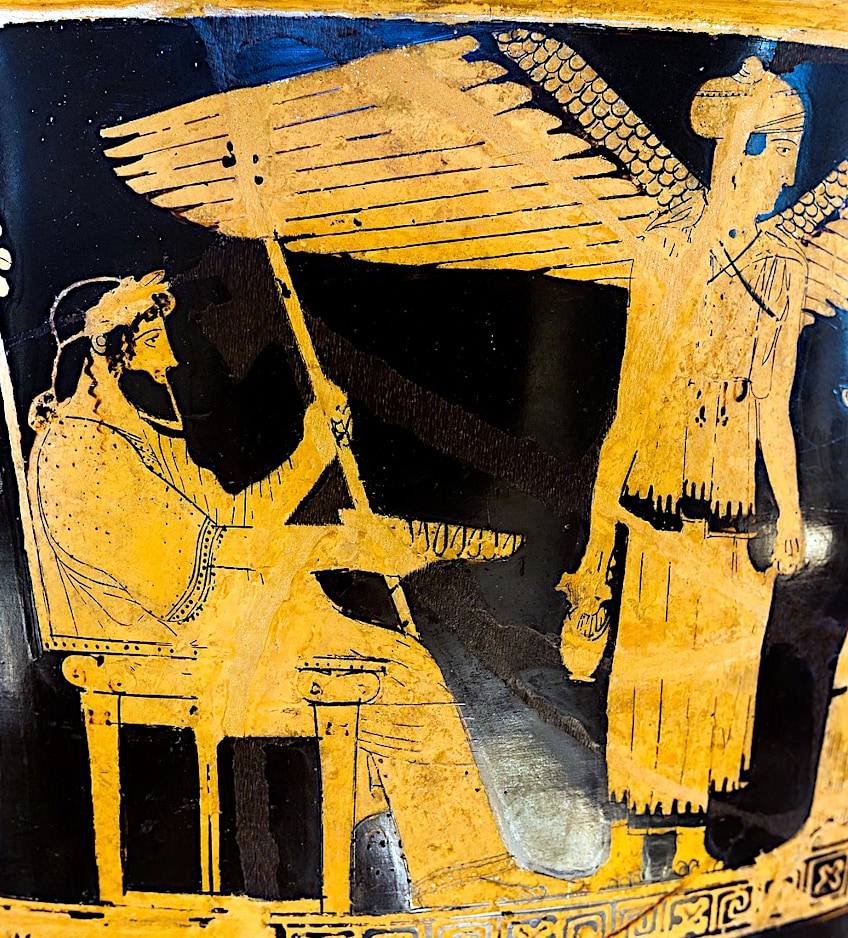 Attic red-figure bell-krater with a depiction of Zeus and Nike by the Niobid Painter (c. 460 BCE); ArchaiOptix, CC BY-SA 4.0, via Wikimedia Commons
Attic red-figure bell-krater with a depiction of Zeus and Nike by the Niobid Painter (c. 460 BCE); ArchaiOptix, CC BY-SA 4.0, via Wikimedia Commons
When Typhon once again announced his challenge again in the morning, Zeus collected the clouds all around himself as armor and responded to the monster. Nike led Zeus into war, while Eris, known as Strife, commanded Typhon.
Nike used her shield to defend Zeus while he fought using his thunderbolts and freezing rain.
Zeus was able to overcome Typhon and declare triumph over the Titans by attacking him with ice and fire. Nike drove her father’s chariot as Zeus rode away from the battlefield.
Depiction in Literature
In literature, Nike is also described as a goddess who assesses the perfection of mortals and deities in competition. This function of appraising a god’s or mortal’s level of talent is most seen in combat, when Nike is usually represented on the side of the winner, awarding them victory.
A perfect instance of this may be found in Book 8 of Ovid’s Metamorphoses, where the destiny of the conflict between Crete and Megara hung in the balance; therefore, victory day by day between them hovered on uncertain wings.
However, Nike’s role in measuring success extends beyond military prowess. Usually, the Greek goddess Nike is the one who bestows the reward on the winner. Bacchylides introduces her with the standard epithet “giver of swift gifts” in Ode 11. However, Nike additionally appears as the prize in a tournament to symbolize triumph in certain sources: “the blooms of glory-bringing Victory cultivate for men golden, prominent renown throughout their lives”. Nike is represented in this source as a wreath of flowers to be awarded to the winner of the Panhellenic Games.
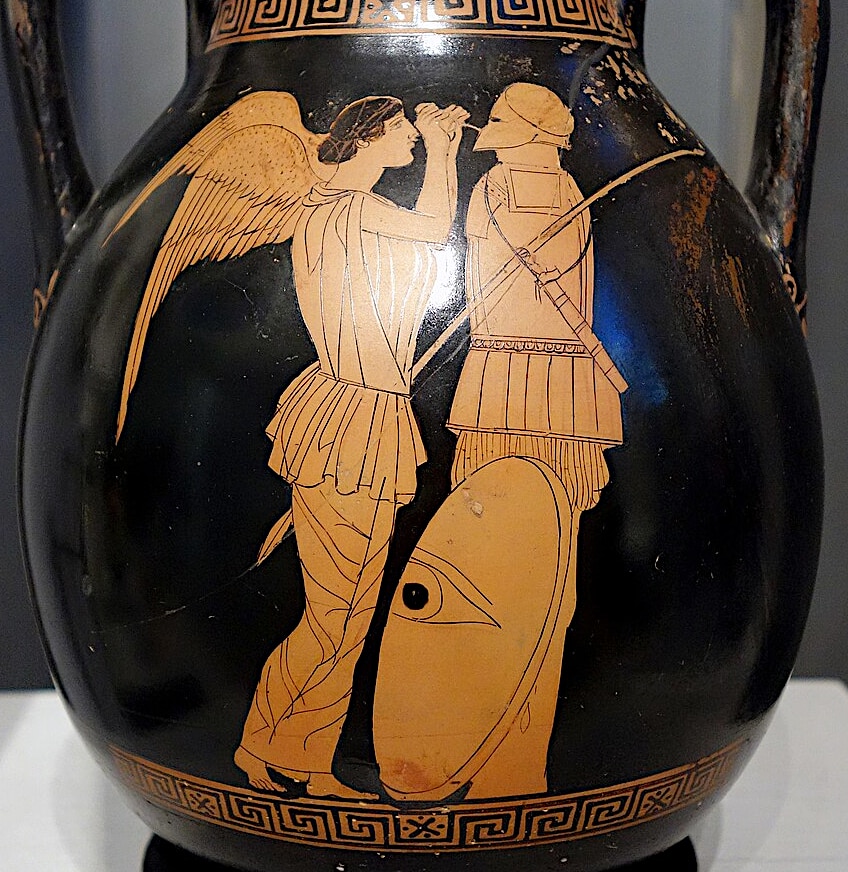 Attic red-figure pelike with a depiction of Nike setting up a battle trophy of captured enemy armor (mid-5th Century BCE); Mark Landon / Wikimedia Commons
Attic red-figure pelike with a depiction of Nike setting up a battle trophy of captured enemy armor (mid-5th Century BCE); Mark Landon / Wikimedia Commons
The Worship of the Greek Goddess Nike
Nike was typically revered along with Athena or as an aspect of Athena in Athens, where she was known as Athena Nike. Nike was worshiped as a manifestation of Athena since Athena was the patron goddess of Athens and so wielded more influence in her own city and acropolis. Because Athena had more influence in Athens, she inherited some of the tasks that had previously been reserved for Nike, as well as her Victory title. As a result, the two goddesses combined to produce the Athena Nike personality.
The separate Nike identity coexisted with Athena Nike in the role of a companion of the Goddess of Athens.
The three votive ceremonies on the Temple of Athena Nike’s parapet demonstrate this bond between Nike and Athena. An array of winged Nikes is represented on both the northern and southern sides bearing offerings to Athena, who is seated at the western extremity of each stream of Nike. As a result of the union of the two deities, Athena Nike became known as the goddess of victory, particularly military success, in Athens.
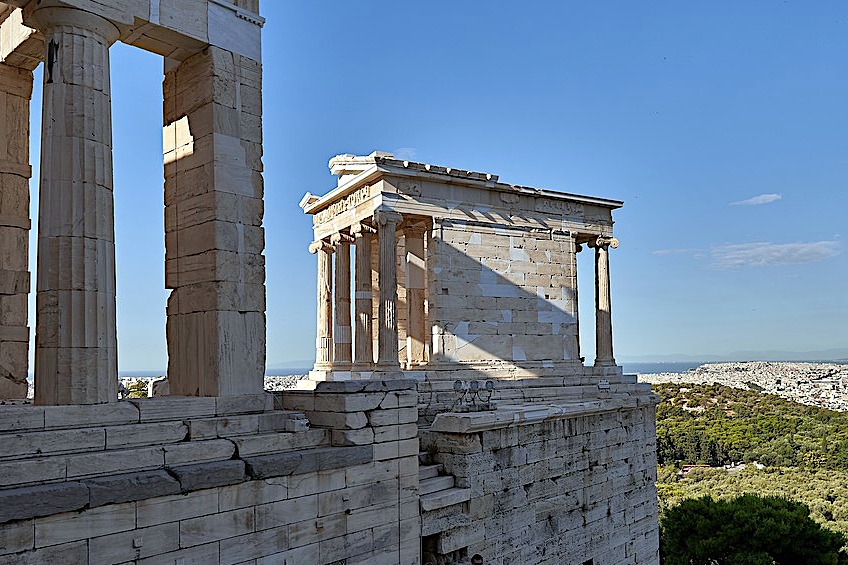 Remains of the temple of Athena Nike overlooking the entrance of the Athenian Acropolis; George E. Koronaios, CC BY-SA 4.0, via Wikimedia Commons
Remains of the temple of Athena Nike overlooking the entrance of the Athenian Acropolis; George E. Koronaios, CC BY-SA 4.0, via Wikimedia Commons
The Athena Nike Priestess
The worship of Athena Nike was active as early as the early 6th century. However, there is considerable disagreement about whether the Athena Nike cult had its own priestess, had none, or shared a priestess with a neighboring cult in its early years. The earliest solid evidence of an Athena Nike priestess is found in an edict issued by the Athenian Demos in the early fifth century. This decree called for the construction of a new priestess and temple for Athena Nike.
The edict was exceptional in that it handed over the authority of the religion to the state and established a democratic process for choosing the next priestess by lot among all Athenian women.
The priesthood was formerly ruled by a genos, or familial clan, which chose the next priestess from among their heirs. The Athena Polias priestess, for instance, was the successor of the aristocratic Eteoboutadai genos, who commanded the priesthood for Athena Polias. As a result, choosing a priestess in Athens was not usually a democratic procedure. According to Josine Blok, this edict was especially noteworthy since it provided all Athenian women access to powerful and significant cultic roles in the Athenian city-state at a period when Athenian women’s liberties were quite limited.
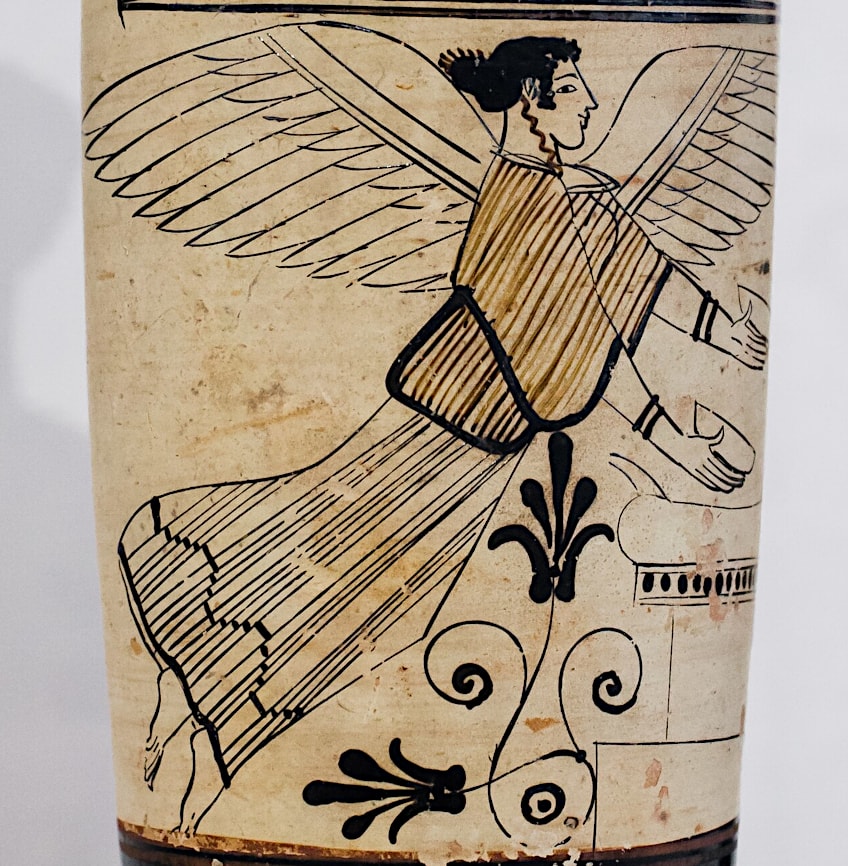 Attic red-figure white ground lekythos with a depiction of Nike flying towards an altar by the Bowdoin Painter (c. 480-460 BCE); ArchaiOptix, CC BY-SA 4.0, via Wikimedia Commons
Attic red-figure white ground lekythos with a depiction of Nike flying towards an altar by the Bowdoin Painter (c. 480-460 BCE); ArchaiOptix, CC BY-SA 4.0, via Wikimedia Commons
The decree’s last odd feature was that it departed from Athenian custom by transferring responsibility for the priests from the genos to the authorities. The ancestral practice was important in how Athenian cultic ceremonies and sacrifices were carried out. Thus, a departure in tradition to shift religious power from the genos to the rulers was unusual for Athens at the time since it converted the worship of Athena Nike into a polis-cult, a religion supported and regulated by the Athenian city-state.
While the edict does not specify the exact identity of the new priestess, an inscription on a marble stele burial monument indicates that the daughter of Kallimachos, Myrrhine, was the first priestess of Athena Nike to be chosen democratically by lot.
She would have gotten a piece of the sacrifice as well as a salary of 50 drachmas, which would have been paid for by the kolakretai. While neither edict specifies the term of Myrrhine’s service, some scholars believe she would have served for life because such was the custom for Athenian women working in cultic posts.
Nike in the Roman Era
Nike was known as Victoria during the Roman Empire. Victoria, like her Greek counterpart, was largely connected with triumph. She was revered as the bringer of victory, especially in military operations. Victorious commanders and kings credited their victories to her supernatural intervention. Victoria was a key figure in Rome’s imperial worship. The Romans thought that the Roman Empire’s success was due to divine favor. Emperors and legions would give sacrifices and prayers to Victoria in order to guarantee victory and the empire’s dominion.
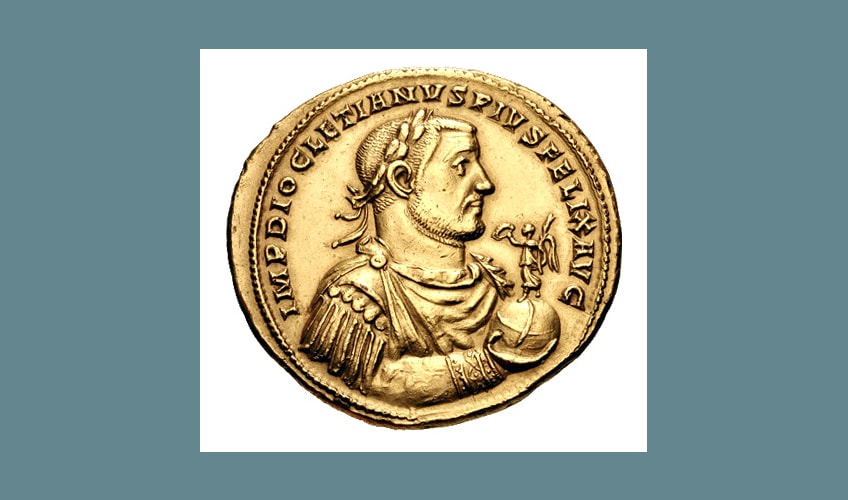 Roman medallion of Diocletian showing the laureate as Jupiter, crowned with a wreath and holding Nike/Victoria in his hand (284-305 CE); Classical Numismatic Group, Inc. http://www.cngcoins.com, CC BY-SA 2.5, via Wikimedia Commons
Roman medallion of Diocletian showing the laureate as Jupiter, crowned with a wreath and holding Nike/Victoria in his hand (284-305 CE); Classical Numismatic Group, Inc. http://www.cngcoins.com, CC BY-SA 2.5, via Wikimedia Commons
Victoria was depicted as a winged figure, comparable to the Greek Nike, to represent her speed and triumphant character. Victoria’s likeness can be found on coins, sculptures, and architectural reliefs, notably triumphal arches, and monuments created to honor her military victories. In the Roman era, Victoria’s link with the military was vital. She would often be seen beside Roman emperors, presenting them with crowns, laurel wreaths, or palm branches as victory emblems.
Victoria was also connected with good fortune and wealth in addition to victory.
She was revered as the patroness of fortune, and her blessings were sought in areas other than conflict, such as politics, business, and personal undertakings.
Nike and the Olympics
Nike’s connection to the Olympics stems from ancient Greek culture and the ancient Olympic Games itself. She occupied a major role in the framework of the Olympic Games as the goddess of victory in Greek mythology. Her presence represented the objective of succeeding and being regarded as the finest in sporting events.
The ancient Olympic Games were held every four years at Olympia, Greece, beginning in 776 BCE. Nike was regarded as a omnipresent throughout these games, presiding over events and bestowing victory on the winners.
Nike was depicted in a number of statues and sculptures around Olympia, including the well-known Nike of Paionios These monuments were dedicated to the goddess, recognizing athletes’ achievements and thanking her for her involvement in their success. In order to obtain Nike’s favor, many athletes and city-states made sacrifices, and prayers, and offered gifts. The “kotinos,” a crown composed of olive leaves, was one of the most prized rewards for Olympic winners. The kotinos represented Nike’s blessing and were put on the victors’ heads. It symbolized not only their athletic victory but also their link to the divine and their ascension to a greater rank.
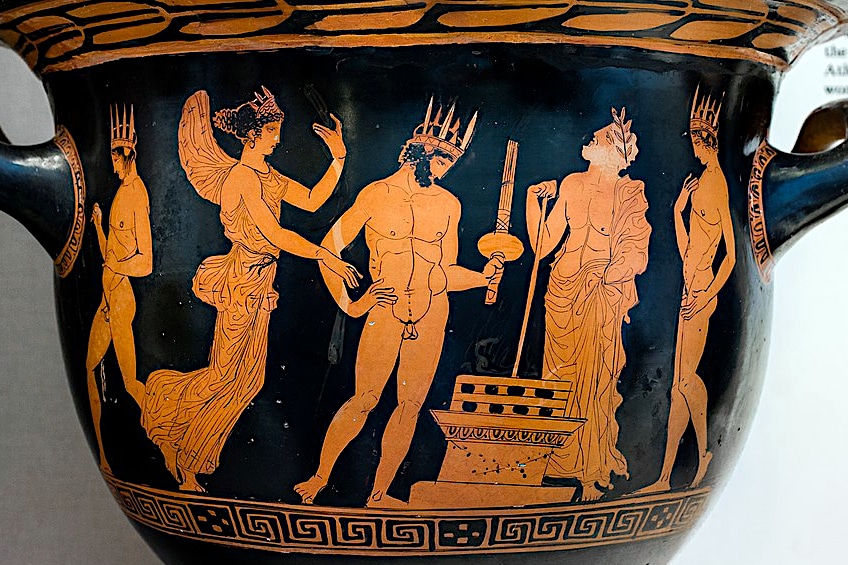 Attic red-figure bell-krater showing Nike leading a victor in a torch race to an altar presided over by an official, by the Nikias Painter, (c. 420-400 BCE); ArchaiOptix, CC BY-SA 4.0, via Wikimedia Commons
Attic red-figure bell-krater showing Nike leading a victor in a torch race to an altar presided over by an official, by the Nikias Painter, (c. 420-400 BCE); ArchaiOptix, CC BY-SA 4.0, via Wikimedia Commons
Athletes competing in the ancient Olympic Games frequently sought Nike’s graces before and during contests. They would pray to her and make sacrifices in the hopes of receiving divine intervention and aid in obtaining triumph. The sanctuary of Olympia housed a large Nike statue known as the “Nike of Olympia.” The Messenians dedicated this monument to Nike as a permanent reminder of her significance in the sphere of victory.
Nike in the Modern Era
Nike’s relationship with triumph and success persists in the present period, although her image has shifted owing to societal developments. Nike, Inc., a global sportswear brand founded in 1964, used her name and likeness in one of the most noteworthy interpretations of her iconography. The name Nike was chosen to signify the company’s ambition of dominating the sports footwear and clothing industries.
The Nike “swoosh” emblem, which was inspired by Nike’s wings, is now known globally.
Nike’s link with triumph and athleticism continues to have an impact on popular culture and athletics. Athletes and sports teams frequently aim for the “Nike spirit” by wanting victory and success. Nike’s trademark image, regularly depicted as a winged figure, has been utilized in sports branding, marketing, and team logos as a symbol of success and motivation.
 Nike House of Innovation in New York; Ajay Suresh from New York, NY, USA, CC BY 2.0, via Wikimedia Commons
Nike House of Innovation in New York; Ajay Suresh from New York, NY, USA, CC BY 2.0, via Wikimedia Commons
The Legacy of Nike
Nike’s most enduring legacy is her affinity with victory. Her name has come to represent triumph and accomplishment. The notion of “Nike” has spread beyond Greek mythology and into many facets of human civilization, including athletics, commerce, and popular culture. The legacy of the Greek goddess Nike inspires people to strive for greatness and achieve their goals. Nike’s legacy is profoundly embedded in the sports world, serving as a continual reminder of the quest for perfection. Nike’s connection with military victories has left an indelible mark on military iconography and customs.
 United States Nike Missile Family photographed in the 1960’s United States Army, Public domain, via Wikimedia Commons
United States Nike Missile Family photographed in the 1960’s United States Army, Public domain, via Wikimedia Commons
Nike’s image, name, and symbolism have been used by military groups and organizations throughout the world to symbolize their quest for success and domination on the battlefield. Nike’s military history reflects the drive for victory, strategic prowess, and the will to triumph over adversaries. Nike’s representation in ancient painting and sculpture made an enduring impact on the realm of artistic expression. Her elegant and winged form has inspired innumerable works of art throughout history, both ancient and modern.
That completes our look at the Greek goddess of victory, Nike. While today, the name, Nike, is synonymous with the shoe and clothing brand, it was originally associated with the goddess that was responsible for bestowing her favor on mortals and gods. It was due to this association with success and victory that companies, such as Nike, used her name and image in their branding and marketing. Even since the days of the ancient Olympics, statues were built in her honor to ensure success. Her ability to assure victory extended beyond athletics and sports, and she was also often called upon in battles.
Frequently Asked Questions
Who Is the Goddess of Victory in Greek Mythology?
Nike is the goddess of victory in Greek mythology. She is often portrayed as a winged figure, symbolizing speed and the power to bring triumph to those worthy of her favor. Nike is a popular Greek mythological goddess who is synonymous with triumph, achievement, and athletics. However, this is not the only role that the Greek goddess Nike is known for playing in the mythology of the ancient Greeks. Nike is also regarded as Zeus’s charioteer. She is often portrayed in Greek art and literature driving Zeus’ chariot during his triumphal parade, reflecting the celestial ruler’s conquering spirit. The Greek goddess Nike is intimately associated with Athena, the goddess of knowledge, combat, and strategic brilliance.
What Is Nike Named After?
Everyone knows the famous logo and name of the Nike brand of shoes and clothing. However, have you ever wondered where the name comes from and what it symbolizes? The brand got its name from the Nike meaning in Greek. This is because Nike was regarded as the Greek goddess of victory. Every company wants to be connected to symbols of success and victory, so it is no wonder that they decided to choose this goddess to represent their company! Not only did they find inspiration in her name, but also in her appearance. The famous Nike company logo is actually meant to represent the wings of the Greek goddess of victory, Nike. Due to her prominent role and representation of triumph, many other companies, sports, and military institutions have likewise used her appearance in their branding too.
What Are the Nike Goddess’s Symbols?
Nike’s most prominent symbols are her wings, which she uses to fly down and bestow her favor on the various mortals and gods of Greek mythology. Another one of her most prominent symbols is the laurel wreath. This is because they were awarded to people when they won a competition. The palm branch is yet another symbol linked to Nike. It stands for victory and is frequently held by Nike as she supports or bestows blessings on triumphant people. When competitors won competitions in the Olympic Games in ancient Greece, they were presented with palm branches. Nike is occasionally seen with a torch, which stands for the flame of victory. The torch represents illumination, motivation, and the dissemination of the winning spirit. It may also represent Nike’s ever-burning torch of victory.

I am deeply passionate about history and am constantly fascinated by the rich and complex stories of the past. As the editor-in-chief of learning-history.com, I have the opportunity to share this passion with a wide audience through the creation and distribution of engaging and informative content about historical events, persons, and cultures. Whether it’s through writing articles and blog posts or creating videos or podcasts, I strive to bring the past to life in a way that is both accurate and enjoyable. My expertise in history, combined with my strong writing and communication skills, allows me to effectively communicate complex historical concepts and make them accessible and interesting to a wide range of readers. I am truly grateful for the opportunity to share my love of history with others through my work on learning-history.com.


